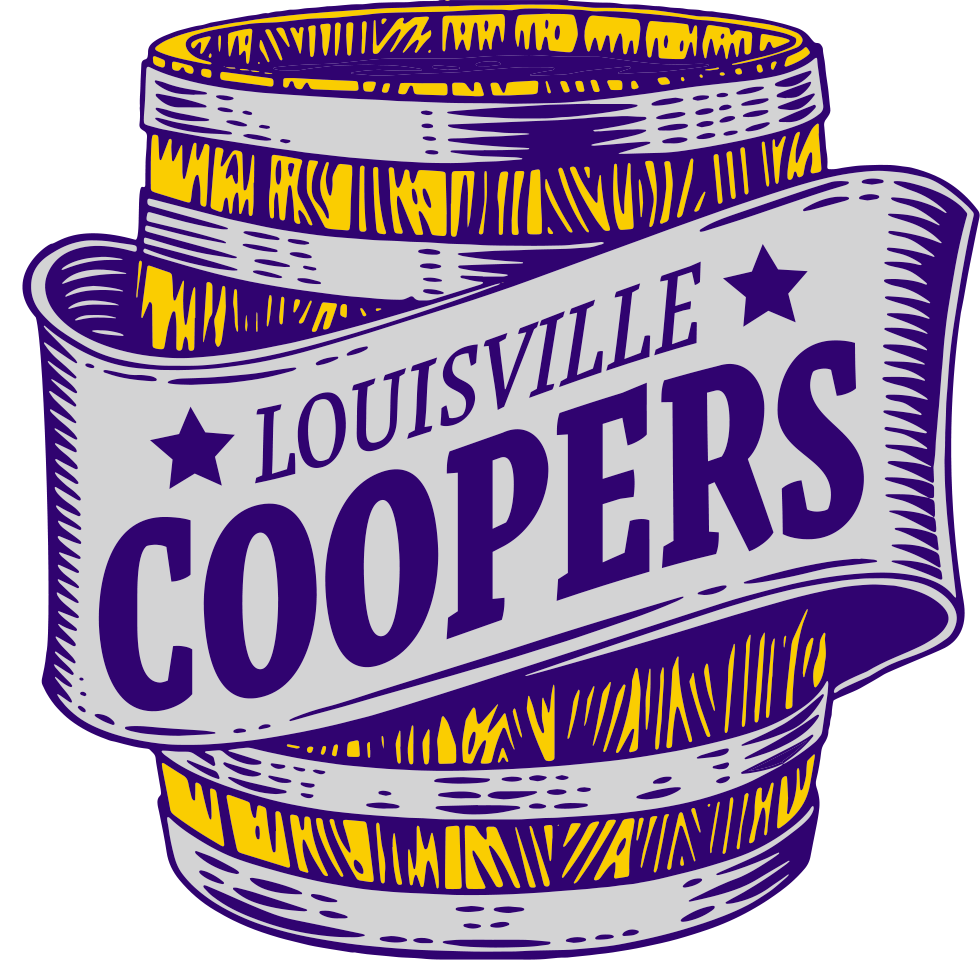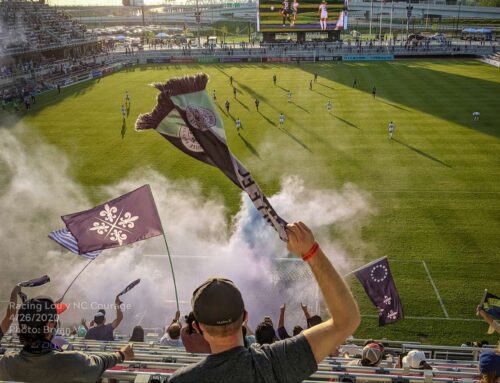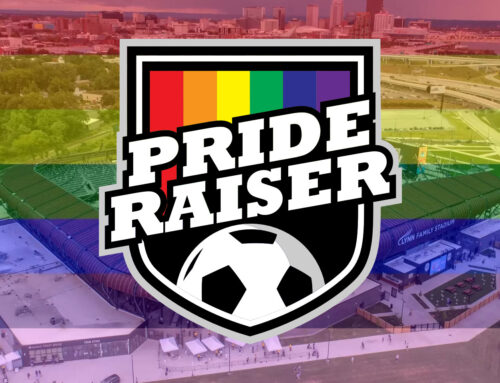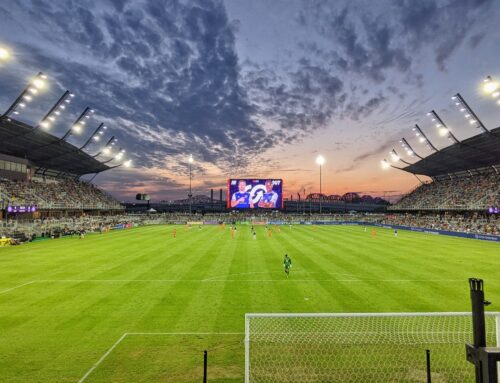It’s officially here! Game Week! There is an actual game that matters happening on Saturday! In the spirit of the beginning of a new season, today we’re debuting another new writer. Welcome to the www.louisvillecoopers.com writing staff, John Wicker! John is a smart guy, a former noob soccer fan, and a member of the Groove Machine. He’s here to tell you, the soccer novice, all about your new favorite pastime.
Soccer 101
You’ve seen something about this Louisville City thing on the news, or maybe one of your friends finally managed to drag you out to see Louisville City play. You’ve no doubt had a great time, but you have SO. MANY. QUESTIONS. I was once like you, too, so I put together a handy glossary of terms and phrases you’ve probably already heard, or soon will.
The Rules
A
bunch of guys in Scotland called IFAB are in charge of curating the Laws of the Game. While there aren’t really all that many, they’re very boring to read! So here’s a much more manageable breakdown:
The Box – A designated area wherein the
goalkeeper can handle the ball. Inside the box, run of the mill
fouls can suddenly warrant a
penalty kick instead of a free kick.
Back-pass – When a team send the ball to their own keeper, unless they head the ball to him, he cannot use his hands.
Corner (kick) – This happens when a team last touches a ball that crosses their own goal line. The other team gets to kick the ball from the corner of the field, yielding them a dangerous scoring opportunity, usually by running a
set piece. These are often the result of the
goalkeeper deflecting a
shot on goal. Referees indicate this call by pointing to the appropriate corner.
Foul – A player did something bad, almost always involving contact with another player, and also usually involving whether or not you made contact with the ball in the process. The other team is given a free kick from the location on the field where the foul was committed.
Free Kick – Free kicks are awarded after a
foul. The referee will point to the spot where the foul happened, and the kick is taken from there. Depending on where the foul happened, the player can touch the set the ball down at that location and then quickly kick it (a quick kick), or try to set up a
set piece. Often, these result in a simple pass. The opposing team is allowed to intercept the ball immediately after it is kicked, and can place themselves anywhere on the field outside of a ten yard exclusion. Free kicks often result in two or more players making a wall and referees painting lines on the field with shaving cream, indicating the closest place where the wall can stand.
Goal kick – This happens when a team sends the ball past their opponent’s goal line. The refereee will point to the corner of the box. The ball is then returned to play by the
goalkeeper, who usually
kicks the snot out of the ball and puts it down field.
Offside – This one gets everybody at first. The person receiving a pass has to be even with the last
defender when the ball is kicked. If they’re farther than the last defender, they’re offside. The
goalkeeper doesn’t count, either. Once the ball has been kicked, though, the player is free to receive it anywhere on the field. The referee calling offside will raise their flag and point it horizontally across the field. The opposing team gets the ball where the offside happened.
Penalty Kick – a free kick usually awarded for a
foul that happens inside the box. Taken from
the spot, it’s just the
goalkeeper versus the shooter, at least until the ball is kicked. The goalie cannot leave the goal line until the ball is kicked.
Red card – When you screw up REALLY badly. This means you’re out of the match, AND you can’t play in the next match, AND your team is now down a player for the remainder of the match.
Shot (on Goal) – an attempt to score, by putting the ball past the goal posts. A shot that would score without the intervention of the
goalie is called “on frame.”
Stoppage Time – There are no timeouts in soccer, but the game does have breaks when players substitute into the game, or for injuries, or even water breaks and the like. The
fourth official is supposed to keep track of all those delays, and at the end of each half, they announce that there will be
stoppage time roughly equalling the amount of time wasted. Essentially, it’s supposed to mean that there are actually 45 minutes of playing time, even if one of the players from Cincinatti is vieing for an Academy Award based on his portrayl of someone in agony after not actually being touched by another player.
Throw-In – Throws in happen when the ball goes out of bounds on the sideline. They are awarded to whichever team did NOT last touch the ball. Fun note: unlike a kick, you cannot be called
offsides when receiving a throw in. Iceland tore up some teams using this trick during the 2016 EuroCup.
Yellow Card – The player
fouled someone so badly that they’re getting an official warning. The ref pulls a yellow card out of their pocket, shows it to the player, and then writes the player’s name on the yellow card. Also called a “booking.”
Yellow cards are also sometimes given for repetitive fouls by a player over the course of a game.
A second yellow card issued to a player during the same match will then result in them receiving a
red card.
Positions
Forward/Striker – This player looks to score goals. They are usually great ball handlers, and are primary scorers for the team. Some forwards create opportunities for themselves (Matt Fondy) and others are there to capitalize and pounce on things that come their way (Chandler Hoffman).
Defender/Back/Fullback – This position is a defensive player. They are charged with getting themselves between the ball and the goal, taking the ball away from attackers, and generally slowing them down long enough to allow other players, especially the
goalie, to get in a better position in the event of a
shot on goal.
Goalkeeper/Goalie/Keeper – This player is charged with keeping the ball out of the goal, and is the only person on the team who is allowed to use their hands, at least whent they’re inside the
box. They wear a different colored kit than the rest of their team to indicate their status as a goalie, and therefore a handsy kind of player.
Midfield – These players are usually split into defensive midfielders, who help out the defense, and attacking midfielders, who play more forward and assist with scoring. These guys run all over the dadgum place. They are often like a point guard in basketball, helping direct play and affect the flow of the game.
General Terms
The Beautiful Game – Boxing is the sweet science. Soccer is the beautiful game.
Fourth Official – You have a referees in the middle of the field, who handles watching out for
fouls and stuff, and one on each sideline, who mainly call
offsides and out of bounds. Then there’s the fourth official, another referee charged with handling time-keeping, and substitutions. They probably do other stuff, but who cares, they’re lowest ref on the totem pole.
Groove Machine– the drum line for the Coopers. You’ll find these maniacs beating drums during the game, including the big barrel drums, and leading the way during the
march. Their job is to support the
supporters, and they are always ready to welcome new members. No prior experience required.
(Insert Color) Team Sucks – The referees wear matching colors during a given match, and that color will be such that it does not conflict with the color of either the home or away team. They kind of look like a third team out there. And when they make a bad call, or just one that the Coopers don’t like… they will often express their displeasure by letting them know that the team wearing the referee’s colors are less than desirable.
Kit – the team’s uniform. There is a home kit, and an away kit, and sometimes even a third kit. Louisville City wore their third kit at all of their away games last season.
March – not the month, or that basketball madness thing. A general gathering of
supporters that arrive at the match
en masse, chanting, singing, beating drums, making noise, and making their presence known far and wide. This is one of the bedrock principles, and chief benefits, of being a
supporter. Not to be missed!
Match – a soccer game isn’t a soccer game – it’s a soccer match. Or a game, too. This is America. Call it what you want.
Pitch – we currently play at a baseball stadium, but the pitch here doesn’t involve a little white ball or a bat. The pitch is the playing field. It’s also okay to call it a field.
Set Piece – Soccer is a fluid and dynamic game which doesn’t lend itself to plays the way certain other sports do, but there are certain times when you can position players and try to do something fancier. Set pieces usually come on
corner kicks and close
free kicks, and a team with well practiced set pieces can be downright dangerous.
Supporter – generally, a fan of a given team. The degree to which a supporter smells like an actual athletic under garment varies by which team they support.
Supporters Group – a gathering of like-minded fans, of which the Coopers are one. Since we support the best team in the world, we do NOT smell like athletic supporters at all.
The Spot – a designated location where
penalty kicksare taken. Not close enough if you’re the one taking the
shot, and far too close if your keeper is defending the shot.
Turf Monster – Slugger Field has lots of grass, but the areas of the pitch normally used as a baseball infield are covered by turf during Louisville City matches. This can create a significant difference in the “friction co-efficient”, and visiting players often find themselves wondering how they wound up on the ground when making that transition. When this happens, it’s like a Turf Monster has grabbed their feet and tripped them up. As an offering to the Turf Monster, the Magic Groove Band often plays “Wipeout” after a particularly fun slip.






